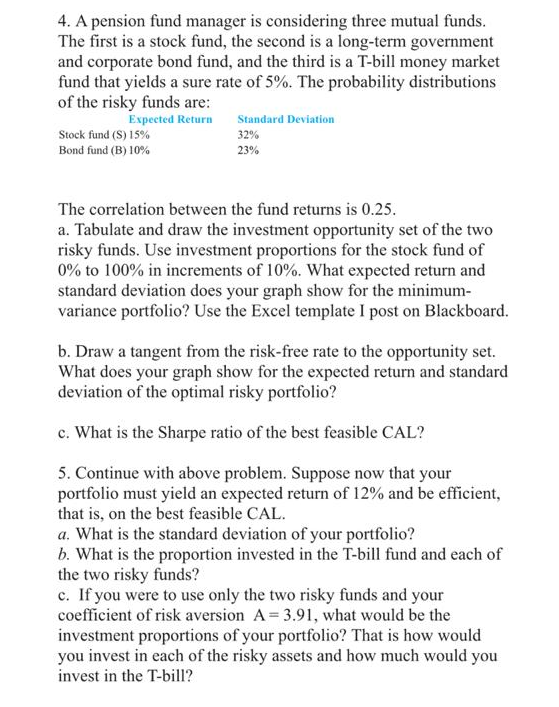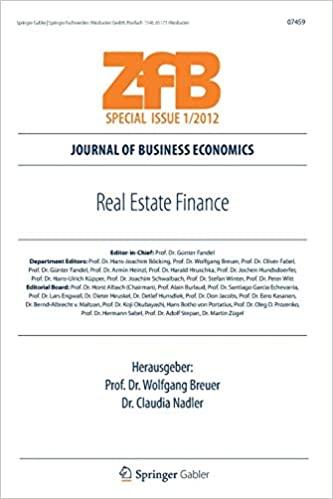Answer Question 5 only please with explanation if needed

4. A pension fund manager is considering three mutual funds. The first is a stock fund, the second is a long-term government and corporate bond fund, and the third is a T-bill money market fund that yields a sure rate of 5%. The probability distributions of the risky funds are: Expected Return Standard Deviation Stock fund (S) 15% 32% Bond fund (B) 10% 23% The correlation between the fund returns is 0.25. a. Tabulate and draw the investment opportunity set of the two risky funds. Use investment proportions for the stock fund of 0% to 100% in increments of 10%. What expected return and standard deviation does your graph show for the minimum- variance portfolio? Use the Excel template I post on Blackboard. b. Draw a tangent from the risk-free rate to the opportunity set. What does your graph show for the expected return and standard deviation of the optimal risky portfolio? c. What is the Sharpe ratio of the best feasible CAL? 5. Continue with above problem. Suppose now that your portfolio must yield an expected return of 12% and be efficient, that is, on the best feasible CAL. a. What is the standard deviation of your portfolio? b. What is the proportion invested in the T-bill fund and each of the two risky funds? c. If you were to use only the two risky funds and your coefficient of risk aversion A=3.91, what would be the investment proportions of your portfolio? That is how would you invest in each of the risky assets and how much would you invest in the T-bill? 4. A pension fund manager is considering three mutual funds. The first is a stock fund, the second is a long-term government and corporate bond fund, and the third is a T-bill money market fund that yields a sure rate of 5%. The probability distributions of the risky funds are: Expected Return Standard Deviation Stock fund (S) 15% 32% Bond fund (B) 10% 23% The correlation between the fund returns is 0.25. a. Tabulate and draw the investment opportunity set of the two risky funds. Use investment proportions for the stock fund of 0% to 100% in increments of 10%. What expected return and standard deviation does your graph show for the minimum- variance portfolio? Use the Excel template I post on Blackboard. b. Draw a tangent from the risk-free rate to the opportunity set. What does your graph show for the expected return and standard deviation of the optimal risky portfolio? c. What is the Sharpe ratio of the best feasible CAL? 5. Continue with above problem. Suppose now that your portfolio must yield an expected return of 12% and be efficient, that is, on the best feasible CAL. a. What is the standard deviation of your portfolio? b. What is the proportion invested in the T-bill fund and each of the two risky funds? c. If you were to use only the two risky funds and your coefficient of risk aversion A=3.91, what would be the investment proportions of your portfolio? That is how would you invest in each of the risky assets and how much would you invest in the T-bill







